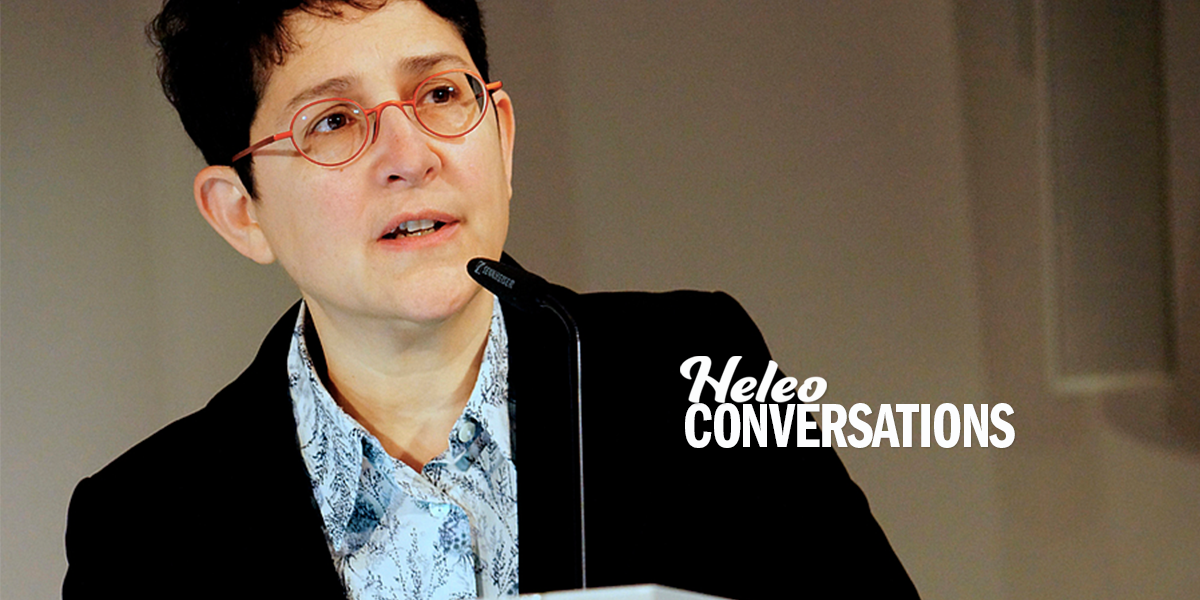Mary Cappello is a professor of English and Creative Writing at the University of Rhode Island, a 2011 Guggenheim fellow in Creative Arts/Nonfiction, and the author of five books of literary nonfiction. Her work has been featured in The New York Times, Salon, The Huffington Post, and the Best American Essays. She recently joined Heleo’s Assistant Editor, Mandy Godwin, in a conversation about her most recent book, Life Breaks In: A Mood Almanack, whether we’re entering a newly moodless age, and what effect technology will have on our collective moods.
Mandy: What inspired you to work on mood?
Mary: I’ve been thinking about mood for at least 15 years. There was a real range of things that brought me to the subject.
First and foremost, I’m interested in subjects that are at the core of our sense of ourselves, that are out-of-view or for which there doesn’t seem to be a language. Then there was the fact, and this is still true, that mood is the basis of a vast pharmacology and at the same time there’s really no agreement in the harder social sciences on what mood is.
I didn’t want to try and pin it down, but to return it to its mysteriousness, to honor that, and to show that it’s really not chartable. That doesn’t mean we shouldn’t be trying to pay loving attention to it. I was pushing back against a shrunken lexicon that attends our feeling states. When I tell people I’m writing a book about mood, they assume I’m writing a book about depression, which in itself is depressing. Because, of course, mood is so multi-various and shaded and nuanced. How it is that we have come to equate mood entirely with depression?
I also came to mood through an interest in sound. In particular, having read the work of a French psychoanalyst named Didier Anzieu and some of the people who have written about him, like the British cultural theorist Steven Connor, who comment on and refer back to his really wonderful idea, of what he calls the sonorous envelope.
This is the notion that, as babies, we get our sense of ourselves as embodied, as having a skin, not only from the way in which we’re held, but from the voice of our earliest caretaker. This voice works as an envelope. This seems so analogous with the way mood operates. I think of mood very much as invisible envelopes. So I thought, “I can pursue this relationship between sound and mood. Sound calls forth mood and asks me to think about it.”
Mandy: Why is it so important right now?
Mary: I’m not the only one to suggest that we might be entering a moodless age. This comes up in a book by a Stanford comparativist named Hans Gumbrecht, who wrote a book called Atmosphere, Mood, Stimmung. Stimmung is the German word for mood, which brings us back to sound quite beautifully, because the German implies the other word Stimme, for voice and skin, in a way that the English does not.
He proposes this briefly in his book and I came to the same conclusion rather independently and maybe from a different access. I noticed that, especially as a teacher, there is a new kind of affectlessness that manifests even in the faces of my students. Especially the women students. Almost like a studied refusal to manifest feelings on their faces.
Then there’s the even more complex implication of what it means to experience intimate enclosures, not just in solitude, but with other people. We are undergoing a sea change as a result of spending most of our time before screens. What happens once we start using all of the surfaces that are available to us to project our information onto? What then happens to the idea of atmosphere around the dwellings that hold us? All of this, to me, has a lot of to do with what it means to experience both individual and collective mood.
Trending: 5 Reasons Life Gets Better After Your 40s
Mandy: The way that you structured the book makes it seem as though it opens up again and again the more you dive into it. It almost reflects the temporal quality that you’re talking about, in terms of sound and light. There’s so much within mood that has to do with duration.
“What distinguishes a mood from an emotion is its duration. Moods can be the length of a pin prick. What I love is that who knows how long the mood will last? We don’t seem to have control over that.”
Mary: Absolutely. Temporality is so yoked to mood. That’s what distinguishes a mood from an emotion, its duration.
Moods can be the length of a pin prick. What I love is that who knows how long the mood will last? We don’t seem to have control over that. So what does control the temporality of moods?
By the end of the book, I really started to think that mood exists in a different temporality than we do. I don’t want to sound kookily abstract, but this is why mood is so difficult to talk about, because it resists our narrative tendencies. Narrative implies one kind of temporality, a moving forward in time. Moods don’t move forward—they’re amorphous, they seem to move in a planar-like way rather than in a linear way.
Even beyond that, there’s some sense that mood states are pre-conscious and our consciousness is always trying to make things that are not coherent, cohere. When we do that, we rely on a sense of time that we’re used to thinking of in terms of past, present, and future. I really don’t think that moods exist on the same temporal plain as the human beings that experience them do.
They start to suggest to us a phenomenon that’s a part of our reality, but that we don’t really have the tools to yet wholly comprehend.
Mandy: Could you speak to the impulse behind wanting to control and limit the vocabulary for mood? Is part of that impulse wanting that temporality to jive with our standard “arrow of time” kind of temporality?
Mary: I’m really interested in the nature of influence, acceptability, and impressionability. As a writer, an artist, one must be susceptible. With the susceptibility, of course, there’s so many cognates that I think are important to even being a responsible human being. Vulnerability, for example.
Maybe what you’re asking gets us into realms of pushback against our own vulnerabilities, our own precariousness, the real call to be open. We resist this sense that there are forces that are acting upon us all the time that we really can’t control.
But we can come to know them better—even know, though, is too harsh a word. We need to accompany them, become their thoughtful companions.
Mandy: It seems as though we almost need the French distinction for that: the savoir/connaître difference.
Mary: Interesting. I was recently re-reading Roland Barthes’ selection that he gave when he took the position at the Collège de France in the 70s. He brings us back to how savoir is related to the word in French, savor, and wanting to restore that pleasure also to savoir. What a great return.
Another keynote to the project was this phrase in the work of David Alan Mellor. He was writing about photographs in various Natural History Museums and he talks about a photographer wanting to restore mystery to something that has been sanitized. He uses the phrase, “A mystery under threat.” I bring this phrase as an answer to the question of “why do we want to control that which affects us and that we don’t understand?”
“There was always this sense about our culture that we are realists at heart, dating back to Hawthorne saying, ‘Keep the imagination sane.’ The way in which Poe was never really fully accepted.”
I think it’s partly that we’re uncomfortable with that which is mysterious. It’s a particularly American way of being. One of my areas of expertise used to be 19th century American literature, and there was always this sense about our culture that we are realists at heart. Dating back to Hawthorne saying, “keep the imagination sane.” The way in which Poe was never really fully accepted.
Here we arrive in the 21st century with someone who is a reality TV star elected President. We’re not a people who are much interested in nuance. We’re known for being pragmatic realists. You don’t find that kind of American cultural tendency toward subtlety and mystery. This is not an answer as to why we as humans might resist mood’s effect on us, but maybe why we as Americans might.
Trending: 5 Simple Strategies for Persuading Anybody
Mandy: That makes a lot of sense, given that there doesn’t seem to be one overarching reason why humans ever do one particular thing. It’s very contextual.
Mary: Absolutely.
Mandy: Thinking about the ways that you got at the description of mood, you used descriptions from clouds, from music, and all of those different tools helped me as a reader to get at a larger picture of mood. Which one felt most apt to you, if any?
Mary: I do think that the cloud analogy was the one that was the driving force. But at the same time, I am reluctant to settle on one, because what I was trying to do was, by way of the cloud metaphor, to allow mood to be more mobile and suggest to me the forms it might want to take, that a taxonomy of emotion that is often tacked onto it does not allow for.
Usually when you ask people to think about moods, they immediately move to the realm of feeling. It makes sense. When you look at the social science on feeling and moods, you find that there’s still not a clear comprehension of what distinguishes the two, and I start to want to say, “Maybe we should dispense with those categories altogether.”
I can do this because I’m a writer and not a social scientist, not a psychiatrist, not a philosopher even. My hope is that the freedom that I can allow myself will make possible new avenues for people in those other disciplines.
So, for example, mood and gravity. We think about feeling down or up, light or heavy. Mood as air. I’m interested in the literal quality of the air in which we move, the air through which words travel. Might this have something to tell us about mood? Mood and scale. Mood and architecture.
So I don’t want to say that one was more apt than the other. Because in the end, what mood teaches me is that it wants a multi-form, it’s perpetually challenging and testing the limits of our imagination.
One of the other things that occurred to me after I had written the book was that it was an ode to the imagination. If someone else were to respond to mood, they would come up with something entirely different. Where would mood take them? The other thing that surprised me was the extent to which I found myself returning to child mind. Going back to the place during arts and crafts in kindergarten and thinking about the relationship between what we were encouraged to make as children and what we allow ourselves to make as adults.
I came to realize that this has everything to do with the moods that are then available to us. It has a lot to do with our own making and how we’re encouraged to create or not.
Trending: 40 Nonfiction Books to Look Out for in 2024
Mandy: It seems as though in childhood our moods are allowed and encouraged to be far more expansive and expressive than they are as adults.
“I think that most of us are interrupted in our imagining at a certain point along the way.”
Mary: Yeah.
Mandy: I wonder whether that is even more true as we go into this, as you say, affectless age? Because as a young adult in this day and age, it seems to me that there’s a rather stark divide in what we’re encouraged to feel and produce as children and how little we’re encouraged to feel and produce as adults.
Mary: You’re probably right. I think that most of us are interrupted in our imagining at a certain point along the way.
I think it actually happens in childhood, this clamping down. The book is called Life Breaks In, and interruption figures in a variety of ways. It’s always seemed to me that childhood is about being interrupted in play. We might be encouraged to play, but so much of our childhoods are about being taken out of play. The ways in which adults break into that play and don’t allow children to dwell more in a space of imagining, by projecting their own needs and their own desires unto us. There are all kinds of ways in which the culture staunches play.
I went to hear Lynda Barry last year at Rhode Island School of Design. She was amazing, and one of the things she said in this talk that stuck with me was why are we encouraged away from picture books and toward words? We are also not taught how to draw. We are taught to read and write.
There’s this assumption that words are higher, it’s developmental. You’re supposed to move from the language of pictures to the language of words. Of course, there’s places we can go, cognitively, imaginatively, even ethically, with images that we cannot go with language and vice versa. What’s the implication of having subordinated one to the other?
I love this insight. It’s so fundamental, but something we never think about. What would have happened if we were encouraged to draw with the same intensity and attention and value that we are encouraged to read and write?
Artists, writers are people who return to the space of interruption in continuing to play again. You go back to the place where you were interrupted and revisit and explore it. I think that is what it means to make art.
This conversation has been edited and condensed.



























